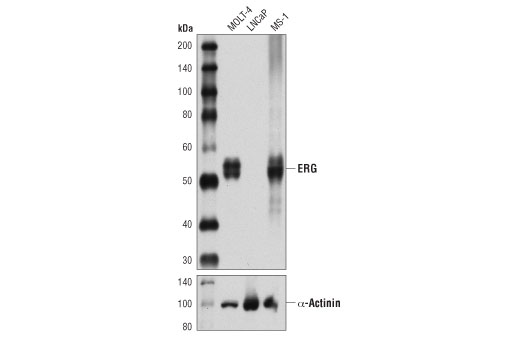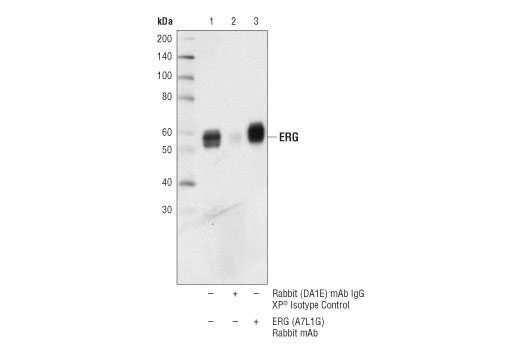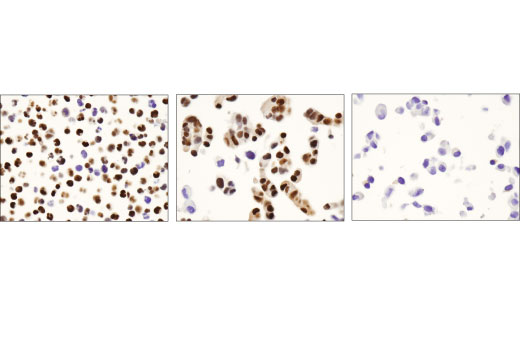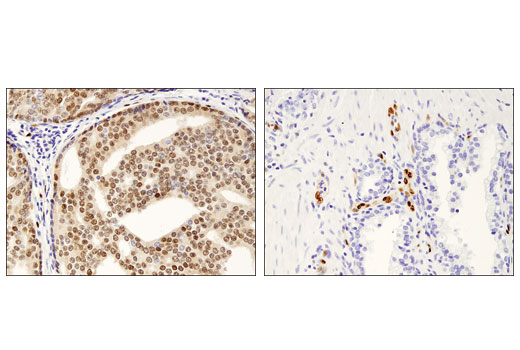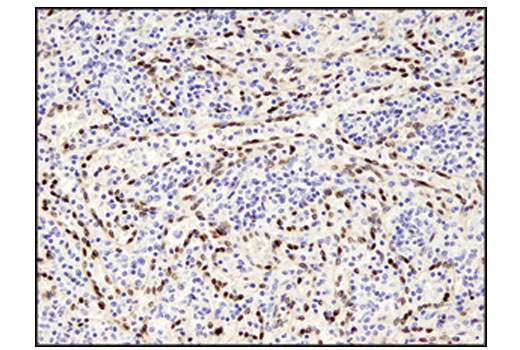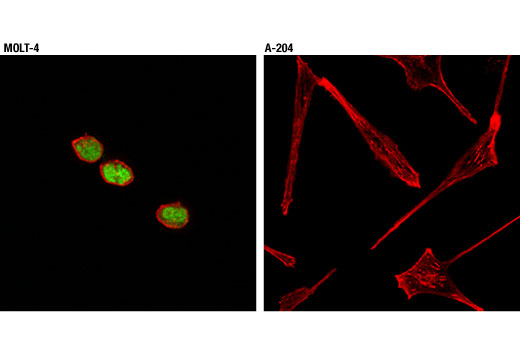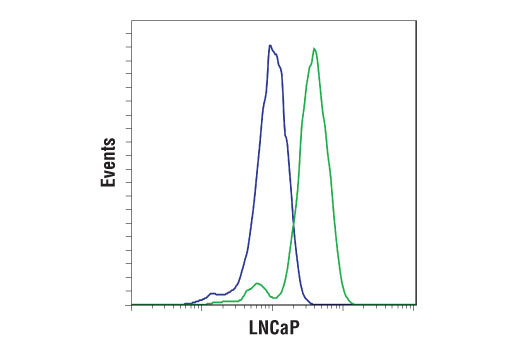WB, IP, IHC-P, IF-IC, FC-FP
H M
Endogenous
54
Rabbit IgG
#P11308
2078
Product Information
Product Usage Information
| Application | Dilution |
|---|---|
| Western Blotting | 1:1000 |
| Immunoprecipitation | 1:100 |
| Immunohistochemistry (Paraffin) | 1:200 |
| Immunofluorescence (Immunocytochemistry) | 1:500 |
| Flow Cytometry (Fixed/Permeabilized) | 1:50 |
Storage
For a carrier free (BSA and azide free) version of this product see product #45381.
Specificity / Sensitivity
Species Reactivity:
Human, Mouse
Species predicted to react based on 100% sequence homology
The antigen sequence used to produce this antibody shares
100% sequence homology with the species listed here, but
reactivity has not been tested or confirmed to work by CST.
Use of this product with these species is not covered under
our
Product Performance Guarantee.
Rat, Hamster, Pig, Horse, Guinea Pig
Source / Purification
Monoclonal antibody is produced by immunizing animals with a synthetic peptide corresponding to residues near the carboxy terminus of human ERG protein.
Background
ETS-related gene (ERG) is a member of the E-26 transformation-specific (ETS) family of sequence-specific DNA-binding transcription factors (1). ERG plays important and highly conserved roles in vertebrate development. Early in embryonic development, ERG is highly expressed in the embryonic mesoderm and endothelium, where it plays a critical role in the formation of the vascular system, urogenital tract and bone development (2,3). Later in embryonic development, ERG functions to regulate the pluripotency of hematopoietic stem cells, endothelial cell homeostasis and angiogenesis (2,4-7). ERG expression is not restricted to development. In adult mouse, ERG is normally expressed in endothelial tissues, including adrenal, cartilage, heart, spleen, lymphatic endothelial and eosinophil cells (8). However, deregulation of ERG activity, often resulting from chromosomal rearrangements, has been implicated and linked to poor prognosis in a number of different cancers. Chromosomal translocations generating EWS/ERG chimeric proteins comprised of the amino-terminal transactivation domain of Ewing’s sarcoma breakpoint region 1 (EWS) and the carboxy-terminal ETS domain of ERG have been identified in 5-10% of Ewing’s sarcoma, an aggressive bone and soft tissue tumor (9). Chromosomal translocations between ERG and TLS/FUS or ERG and ELF4 have been implicated in acute myeloid leukemia (10, 11). Over-expression of ERG, resulting from gene fusion with the androgen-driven promoter of the TMPRSS2 gene, has been identified as a key driver of metastasis and marker for poor prognosis in prostate cancer (12).
- Adamo, P. and Ladomery, M.R. (2016) Oncogene 35, 403-14.
- Birdsey, G.M. et al. (2008) Blood 111, 3498-506.
- Vijayaraj, P. et al. (2012) Development 139, 3973-85.
- Ng, A.P. et al. (2011) Blood 118, 2454-61.
- Birdsey, G.M. et al. (2015) Dev Cell 32, 82-96.
- Lathen, C. et al. (2014) Circulation 130, 1179-91.
- McLaughlin, F. et al. (2001) Blood 98, 3332-9.
- Mohamed, A.A. et al. (2010) J Cancer 1, 197-208.
- Chen, S. et al. (2016) Genes Chromosomes Cancer 55, 340-9.
- Ichikawa, H. et al. (1994) Cancer Res 54, 2865-8.
- Moore, S.D. et al. (2006) Leuk Res 30, 1037-42.
- Tomlins, S.A. et al. (2005) Science 310, 644-8.
Species Reactivity
Species reactivity is determined by testing in at least one approved application (e.g., western blot).
Western Blot Buffer
IMPORTANT: For western blots, incubate membrane with diluted primary antibody in 5% w/v BSA, 1X TBS, 0.1% Tween® 20 at 4°C with gentle shaking, overnight.
Applications Key
WB: Western Blotting IP: Immunoprecipitation IHC-P: Immunohistochemistry (Paraffin) IF-IC: Immunofluorescence (Immunocytochemistry) FC-FP: Flow Cytometry (Fixed/Permeabilized)
Cross-Reactivity Key
H: human M: mouse R: rat Hm: hamster Mk: monkey Vir: virus Mi: mink C: chicken Dm: D. melanogaster X: Xenopus Z: zebrafish B: bovine Dg: dog Pg: pig Sc: S. cerevisiae Ce: C. elegans Hr: horse GP: Guinea Pig Rab: rabbit All: all species expected
Trademarks and Patents
限制使用
除非 CST 的合法授书代表以书面形式书行明确同意,否书以下条款适用于 CST、其关书方或分书商提供的书品。 任何书充本条款或与本条款不同的客书条款和条件,除非书 CST 的合法授书代表以书面形式书独接受, 否书均被拒书,并且无效。
专品专有“专供研究使用”的专专或专似的专专声明, 且未专得美国食品和专品管理局或其他外国或国内专管机专专专任何用途的批准、准专或专可。客专不得将任何专品用于任何专断或治专目的, 或以任何不符合专专声明的方式使用专品。CST 专售或专可的专品提供专作专最专用专的客专,且专用于研专用途。将专品用于专断、专防或治专目的, 或专专售(专独或作专专成)或其他商专目的而专专专品,均需要 CST 的专独专可。客专:(a) 不得专独或与其他材料专合向任何第三方出售、专可、 出借、捐专或以其他方式专专或提供任何专品,或使用专品制造任何商专专品,(b) 不得复制、修改、逆向工程、反专专、 反专专专品或以其他方式专专专专专品的基专专专或技专,或使用专品开专任何与 CST 的专品或服专专争的专品或服专, (c) 不得更改或专除专品上的任何商专、商品名称、徽专、专利或版专声明或专专,(d) 只能根据 CST 的专品专售条款和任何适用文档使用专品, (e) 专遵守客专与专品一起使用的任何第三方专品或服专的任何专可、服专条款或专似专专
